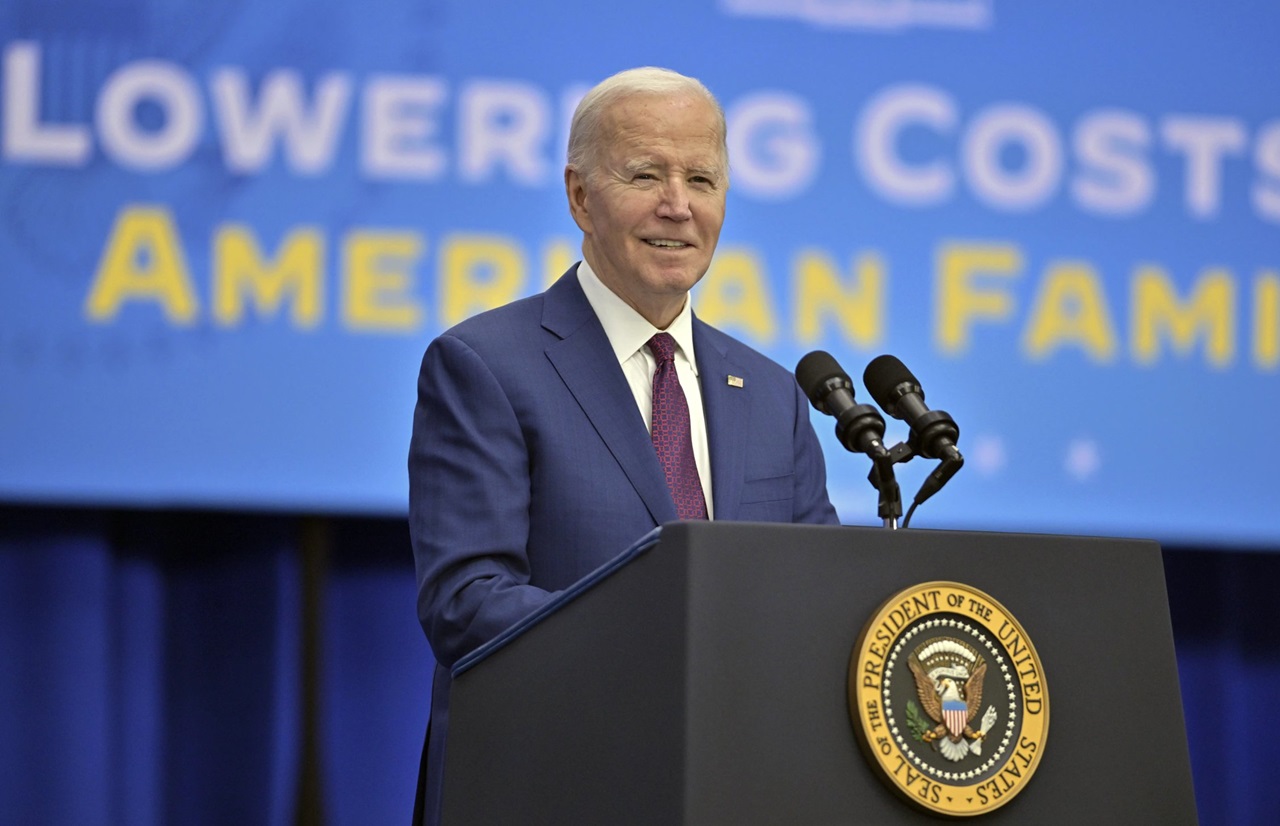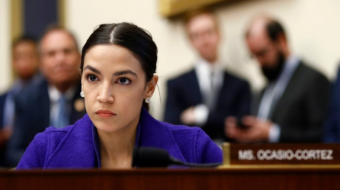
WASHINGTON—Democratic President Joe Biden’s proposed federal budget for fiscal year 2025, which starts October 1, raises taxes on corporations and the rich while—among other priorities—expands federal power to cut prescription drug prices. It also would add tax credits for the poor and middle class.
In short, like all other presidential budgets, it’s a political document. And congressional gridlock, especially in the Republican-run U.S. House in an election year, means that its overall bottom lines are unlikely to survive the congressional sausage factory.
After all, we’re halfway through fiscal 2024, and Congress still has the budgets of six government departments—including Labor, Education, Health and Human Services and Defense—limping along on so-called “continuing resolutions,” or CRs. Based on last fiscal year’s spending, they expire March 22.
Which means that agencies, including those departments and the National Labor Relations Board, will shut down at midnight that day unless lawmakers get their behinds in gear and pass the other money bills. That’ll leave most of the government’s two million workers with shuttered workplaces. Unless, like the military, they’re deemed “essential,” of course.
Despite hurdles and roadblocks, Biden’s budget is important because, even more than his State of the Union address, it sets out his priorities. As the old saying goes, “follow the money.” In this case it goes to some good domestic programs but continues harmful military spending and imperialist policy abroad.
Taxing millionaires and billionaires
An administration fact sheet makes the claim that Biden “has already secured historic legislation to make our tax code fairer, from enacting a corporate minimum tax so that billion-dollar companies can’t get away with paying $0 in federal income taxes to giving the Internal Revenue Service the tools it needs to make wealthy tax cheats pay the taxes they owe.”.
The fact sheet says, in true campaign style, that “President Biden will fight to stop Republican plans to add trillions to the deficit with tax cuts skewed to the wealthy and largest corporations. Republicans would rather add trillions to the national debt than take back even one dollar of the $150 billion annual rate cut corporations received under President Trump. Now, President Biden’s budget will cut taxes for working families and lower deficits by trillions of dollars over a decade by making the wealthy and big corporations pay their fair share—and no one earning less than $400,000 per year will pay a penny in new taxes.”
His proposals in this budget blueprint include raising the corporate tax rate from 21% under the Trump-GOP 2017 tax cut to 28%, doubling the U.S. tax rate on multi-national firms’ foreign earnings—think the “Fiat” share of Stellantis, formerly FiatChrysler–to 21%, enacting legislation to prevent firms from escaping U.S. taxes by technically moving their “headquarters” to foreign tax havens, and denying corporate tax deductions for salaries above $1 million.
“My goal,” Biden told the National League of Cities on budget day, is to cut the federal deficit “by $3 trillion” over the next decade “by making the wealthy and big corporations finally begin to pay their fair share,” he said to applause.
In the early 1950’s the Super wealthy paid more than 90 percent in taxes but lived quite comfortably. The money paid for a nationwide network of highways and infrastructure from coast to coast to coast. Since then the rich and the big corporations, the military industrial complex as President Eisenhower called it, slowly and steadily cut the taxes they were willing to pay. When Ronald Reagan became president he radically reduced those taxes and of course, when he was president Trump cut them even more.
No president, including Biden, has taken Sen. Bernie Sanders’s advice and challenged any of the basic tenets of capitalism or pushed for even mild forms of socialism.
Biden, like all of them, thinks reform within the system can solve all the problems. “Folks, look, I’m a capitalist. If you can earn a billion bucks, wonderful. Just pay your fair share, man, not 8.2% percent.” The applause was continuous. “If you paid 25%, we’d have $500 billion more over the next 10 years to cut the deficit, to provide child care, to do all the things we need to do.”
Tax cuts for the working class
Biden says he wants to restore the full child care tax credit, and make it permanent. It was instituted to help cash-strapped families during the pandemic-caused depression, but Congress let it lapse. He’d bring it back, at an average of $2,600 for 39 million families with 66 million children. That includes “two million children living with a caregiver who is at least 60 years old. It would also provide breathing room for day-to-day expenses by allowing families to receive their tax credit through monthly payments,” a budget fact sheet says.
The problem is that many Democrats, not just Republicans, are not on board with his approach.
The fact sheet further states: “And by strengthening the Earned Income Tax Credit for low-paid workers who aren’t raising a child in their home, the President’s budget would cut taxes by an average of $800 for 19 million working individuals or couples. That includes two million older workers age 65 and older and five million young adults age 18 to 24 who would be newly eligible for the credit.”
Child care aid
That was another pandemic-prompted payment which later lapsed. The difference is those payments went to providers and child care centers, while this one would be structured so that most working families—those with incomes up to $200,000 yearly—would pay between zero and $10 a day for child care. It would aid parents of 16 million kids, and harks back to a World War II system.
More money for OSHA and NLRB
Biden would allot $655 million to the Occupational Safety and Health Administration, slightly more than in the year that began on October 1. Of that, 40% ($262 million, up $19 million from this year) would go for federal job safety enforcement, with another $120 million in federal aid to states—such as New York and Illinois—certified to run their own OSHAs, with the same standards and procedures as the feds.
OSHA could hire 18 more workers, Biden says, raising its workforce to 1,980—100 fewer than in 2023. The number of inspections, combined state and federal, would decline from 68,536 to 68,400, Biden’s budget predicts. Overall, Biden proposes spending $2 billion on labor enforcement, including catching wage thieves.
The NLRB’s workforce will handle a lot more cases, thanks to increased worker activism and organizing since the coronavirus pandemic hit. Biden wants NLRB to get $320 million in the year starting October 1, up from $299 million this fiscal year. It’ll need it: The administration predicts the NLRB workers will handle 30,629 cases in the next fiscal year, 17% more than the 26,264 this year.
“Additionally, the budget includes funding to strengthen the National Labor Relations Board’s capacity to enforce workers’ rights to organize and collectively bargain for better wages and working conditions,” an administration fact sheet says.
No cuts to Social Security and Medicare
Biden’s 2024 election foe, former Republican Oval Office occupant Donald Trump, handed Biden that issue on a silver platter the day the budget came out, by saying he would cut the two big programs and that “there’s a lot of waste and fraud” in both.
“As the president has made clear, he will reject any efforts to cut or undermine the Medicare or Social Security benefits seniors and people with disabilities earned and paid into their entire working lives,” another administration summary says. “The budget honors that ironclad commitment by firmly opposing benefit cuts to either program and by embracing reforms that would protect and strengthen” them. He “strongly rejects congressional Republicans’ attempts to cut benefits for hardworking Americans.” However, Biden opposes Medicare for All. The budget is silent on GOP efforts to privatize Medicare.
To improve Medicare’s finances, Biden would save Medicare—and seniors–$200 billion over a decade by giving it the power to bargain with Big Pharma over lowering drug prices for a wide range of prescription drugs, not just insulin. The $35 monthly price for insulin would be extended to all diabetes sufferers, not just those Medicare and Medicaid cover. And he’d limit generic drug prices to $2 per monthly prescription for common drugs, such as those used to battle high blood pressure.
Trump’s plans to cut Social Security and Medicare “show once again why Joe Biden is the right choice for working families,” AFSCME President Lee Saunders said. “Joe Biden believes that all people
deserve to retire with dignity, and he continues to block any attempt to undermine our hard-earned retirement benefits. With Biden in office, working people can rest assured that Social Security and Medicare will never be on the chopping block.”
$1 trillion to the military
Now the bad news: Biden wants $955 billion, a $75 billion increase in the basic military budget, for the year starting October 1. Basic military spending this fiscal year includes $880 billion in the regular military budget, but Biden still wants $95 billion more in war aid to Israel and Ukraine. And there’s another $20 billion, in the package of spending bills Biden signed the week before, on modernizing U.S. nuclear weapons via the Energy Department.
The dollars spent on the military are making it increasingly unrealistic that the progressive poertions of the Biden domestic budget would ever become reality.
The money for Israel is going to fund the worst genocide of this century and the money for the war in Ukraine is enriching the armaments makers in the U.S. along with the U.S. fossil fuel companies that are selling their products to Europe which has no other choice to purchase from them since the cooperation they had with Russia on fuel purchases has been blown up by U.S. war policy in Ukraine.
The U.S. policy in the Ukraine war has involved continual moves by the U.S. to head off and derail any peace negotiations between Ukraine and Russia.
Besides AFSCME’s Saunders, three other union leaders offered immediate comments on Biden’s budget blueprint. Teachers union leaders were positive, as Biden once again proposed increased education money. But Biden’s federal pay proposal disappointed Government Employees (AFGE) President Everett Kelley.
“With this budget, President Biden underlined his unswerving commitment to fundamental American values—giving families the freedom and opportunity to get ahead and thrive,” said Teachers (AFT) President Randi Weingarten.
“The budget grows the economy from the middle out and the bottom up. (The usual copout from people afraid to emphasize the fact that everyone benefits from lifting up the bottom. “From the middle out” is essentially a meaningless phrase.) It proposes increases to core education programs like Title I, and funds programs that support student learning and college completion. It protects and strengthens Social Security and Medicare. It takes on the largest health-care challenges facing the nation by expanding the healthcare workforce and addressing consolidation, affordability and access to mental and physical healthcare, including reproductive health.
“And it slashes the deficit by about $3 billion by taxing the ultra-wealthy and corporations, which have raked in billions since the Trump tax cuts. America’s educators, healthcare professionals and public employees are proud to have the president’s back, because we know he has ours.”
“All students, no matter their race, place or background, deserve leaders who will give them quality public schools…President Joe Biden’s budget shows he values the voice of parents and educators and that his vision for this country is one where all students–Black and white, native and newcomer, Latino and Asian-American-Pacific Islander are always a top priority,” said National Education Association President Becky Pringle. First Lady Jill Biden, a college professor, is an NEA member.
“President Biden’s budget continues historic investments in public education, including funding for Title I” schools, “community schools, early childhood education, community colleges, historically black colleges and universities, while increasing Pell Grants and relieving student debt.
What Pringle did not say is that Trump-named justices on the U.S. Supreme Court have limited Biden’s student debt forgiveness plans and the Republican-run House wants to freeze Pell Grants.
Biden “understands the issues facing students and families” including gun violence, “which is why he is working to expand school-based mental health services by increasing the number of school counselors, nurses, and mental health professionals” and proposes “investments making our schools and communities safer,” Pringle continued.
“President Biden’s budget would make progress on tax fairness, calling on the wealthiest Americans and large corporations to pay their fair share.”
“And President Biden is working to make higher education more affordable and accessible by expanding Pell Grants, while also lifting the burden of crushing student debt. Since taking office, the Biden-Harris administration has canceled the student debt of nearly four million Americans, including almost 800,000 educators and public servants.”
Pringle called Biden “the most pro-public education president in modern history. The three million members of the National Education Association urge Congress to join President Biden in prioritizing students and families by building on the president’s fiscal year 2025 budget.”
AFGE’s Kelley also lauded Biden’s proposals “to make the rich and corporations pay their fair share of taxes to extend solvency of Medicare, and to increase budgets for critical federal programs.
“However, we are extremely disappointed in the way this budget turns its back on the longstanding practice of pay raise parity for civilian and military employees of the federal government. A 4.5% increase for civilian workers, as requested for our colleagues in the military, would reflect the Employment Cost Index (ECI)” and a federal comparable pay law.” The union actually seeks 7.4%.
Right now, Kelley said, federal workers are 27.5% behind private-sector counterparts with the same experience and skill sets. “A paltry 2% raise for civilian federal employees will do very little to close that widening gap…Ultimately, until we are able to address lagging pay for federal workers, other efforts to recruit, hire, and retain top talent will never be successful because of the albatross of low pay.”
We hope you appreciated this article. At People’s World, we believe news and information should be free and accessible to all, but we need your help. Our journalism is free of corporate influence and paywalls because we are totally reader-supported. Only you, our readers and supporters, make this possible. If you enjoy reading People’s World and the stories we bring you, please support our work by donating or becoming a monthly sustainer today. Thank you!












Comments